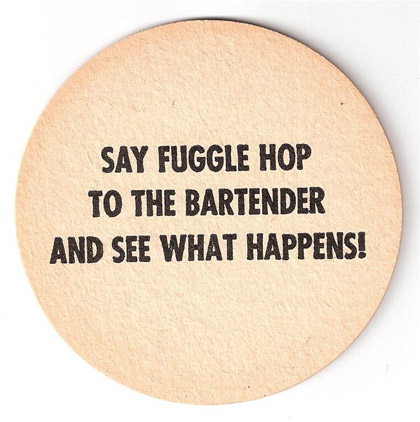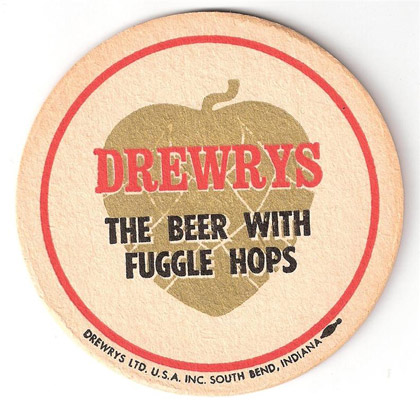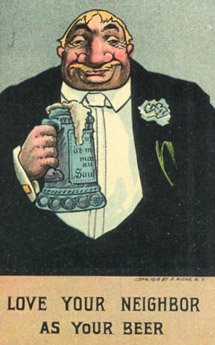
This is a Drewrys beer coaster from the 1950s. Does anybody know what happened if you said “Fuggle hop” to the bartender? Maybe I should turn this into a caption competition à la BrewDog.


This is a Drewrys beer coaster from the 1950s. Does anybody know what happened if you said “Fuggle hop” to the bartender? Maybe I should turn this into a caption competition à la BrewDog.

It started with this email from a friend: “What is the best book on the market that touches on beer, history, styles, glassware, etc.?”
This was an easy one to answer: Michael Jackson’s Beer Companion, even though it was published going on 20 years ago and requires tracking down a used copy.
So easy I thought I might as well extend it to nine more recommendations. Presented in random order (really, I used an online randomizer).
Before we get to that, the context. There’s a good chance if you aren’t Ron Pattinson or Martyn Cornell (or Jay Brooks) that my beer library has more books than yours, but this is all just one man’s opinion and tomorrow I’d probably come up with a different list.
I also made a few rules going in. Only one book per author, because otherwise when do you quit listing Michael Jackson books? Books written in English (or American) because that’s the language I read. No books focusing on the brewing process, because that’s too specialized and besides I write them and I have further relationships with Brewers Publications. No cookbooks. No guidebooks, although some include quite clever writing. No books dominated by photos, such as Beer naturally.
I haven’t included links to buy any of these books, but I recommend shopping at BeerBooks.com, kind of your small, locally owned, friendly bookstore, except online.
In the midst of the discussion about the Wine Enthusiast list of top 25 beers, Jeff Alworth posed a question:
Stan, just to throw a hot potato back at you: if, under penalty of death, you were compelled to come up with a list of the world’s 25 best, what would it be? Actually, I don’t care what the list is as much as I wonder what criteria you would apply to come up with it.
I’d probably rather Jeff provide the criteria and I do the list, but that’s not the real question is it? So, understanding I’m bound to overthink this, here you go.
Am I changing the rules? If you look at the annual (or semi-annual) lists from Rate Beer and Beer Advocate they damn the torpedoes and if three imperial stouts, two doppelbocks and four strong dark ales fermented with yeast from Belgium end up in the top 10 that’s fine. I’d rather read a list that includes 25 beers that represent the best in and the breadth of the world. A cheat? Sorry, I want a helles to have a chance to make the list.
Whose palates will be served? Only those who love big hefty, maybe hoppy, beers? Only those who appreciate pale, delicate beers? Why not everybody.
It’s not a matter of starting with some list, say 10, of the best pilsners from the Czech Republic and hauling them fresh to a judging arena. You must go there and taste them where they are brewed. Same with wheat beers in Bavaria (though not all 1,000 or so available). Timothy Taylor Landlord is not going to be the same on cask in Chicago (site of the next World Beer Cup) as it is anywhere in the U.K. Drink multiple pints or half liters or chalices. If it’s one of the best 25 beers in the world you should rip the arms off of somebody who tries to keep you from finishing your glass.
Did I answer your question? This is another fool’s errand, so feel free to add what I left out in comments.
Curiously, the exercise has helped me focus on why I find trying to identify the very best in the world pointless. If you love beer, on any given Sunday the 343rd best in the world may be better than the 14th.
 I haven’t done a very good job of explaining why I occasionally seem to be a crazy old beer drinker, dashing out onto the lawn (perhaps with a beer in my left hand, shaking my right fist) and shouting, “You kids with the beer lists get out of here.”
I haven’t done a very good job of explaining why I occasionally seem to be a crazy old beer drinker, dashing out onto the lawn (perhaps with a beer in my left hand, shaking my right fist) and shouting, “You kids with the beer lists get out of here.”
I don’t hate lists. In fact, we love them in our family. We compiled many during our grand journey, each year will write down our favorite recordings, periodically our favorite places for green chile, the best hikes we’ve ever taken, the worst airline flights, whatever. But, aside from what we posted in our trip blog, those lists are just for our own amusement. The context is our lives and best kept private.
Context and authority determine the value of a list. For instance, it makes a nice press release for the breweries that made PASTE magazine’s “25 Best American Breweries of the Decade (2000-2009),” but why would you rely on PASTE for your beer recommendations?
I bother to point this out because I enjoy posting lists (though usually not best of) of my own and I’m certain that in the next several weeks I’ll be commenting on the slug of best of the year and best of the decade tomes that will be upon us. I don’t want you to be surprised when I like some of them.
For instance, even though Tom Auer introduced his “Top 5 New Beers of 2009” by explaining he would “flip Stan’s bad attitude about beer lists a bird” I’d call it a good list. The context is clear, new beers a single drinker tried in 2009. He explains his choices in the sort of detail you can provide in a blog and when you stick to a few beers. You don’t have to agree with every characterization (like “so few American craft breweries do lagers well”) to enjoy reading the list.
Now about the advent calendar. We’re also big on them in our house. Jon Abernathy has been posting a Advent Beer Calendar since 2006 and this year he invited other bloggers to contribute. My words are up today, while Jay Brooks and Lew Bryson have also pitched in. What’s turned into a bonus I didn’t think of when he sent the invitation is so far everybody’s writing about a local beer.
Quick disclaimer: Jon’s one of the first bloggers I emailed with when we decided to start The Session. He also was kind enough to let us sleep in his cul-de-sac last July. Yes, we had some fine beer, but no we didn’t pass out in the street. We were safely tucked in our beds in the motorhome.
Now the Village Voice has a list, Our 10 Best Beers. Great fodder — they include a “plebian” list and a “connoisseur’s list” — but a promise is a promise so nothing snarky from me.
Instead I’ll take it out on . . .
An opener for screwcap wines. Did some wine drinker miss the memo? They’re screwcaps. Granted, there is a legitimate use for people with arthritis. But “keeping the romance alive?”
Now back to be the nice guy who buys the next round and a link that should have you smiling right into Happy Hour.
Pete Brown celebrates. As far as I am concerned this paragraph alone makes him worthy of Beer Writer of the Year:
I fucking love beer. I love the taste and appreciation of it. I love the society and culture that surrounds it, and the way it influences society and culture more broadly. I love the history of it, and what that history tells us about ourselves. I love the way it’s an international standard, a universal signifier of unpretentious sociability. I love the fact that I’ve made scores of genuine new friends through it – many of whom I’ve yet to meet physically. I love the way it inspires and intoxicates me – both in a physiological sense and an intellectual one.
But wait, there’s another.
Today I’m going to write my final column of the year for the Publican and then I’m going to a beer festival and/or a bar and I’m going to exceed the recommended daily guidelines of alcohol unit intake. I’m going to get drunk. I’m going to get shitfaced, sozzled, pissed, bladdered, cunted, wankered, soused, and most of the other 1346 words for inebriation I’ve collected over the years. I’m going to have a good time doing it, and the people who are with me are going to have a good time too – a better time than they would if they stayed in and watched the telly. And when I come home with The Beer Widow and a few mates, I’m going to share with them a bottle of Bass Kings Ale, brewed in 1902, which cost me over a hundred quid, and I’m going to marvel at the miracle of beer all over again.
The nice thing is this evening we’ll be drinking something local, maybe on cask, and it will be part of the same miracle.